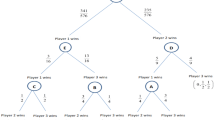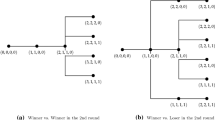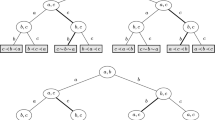Abstract
We study round-robin tournaments with either three or four symmetric players whose values of winning are common knowledge. With three players there are three rounds, each of which includes one pair-wise game such that each player competes in two rounds only. The player who wins two games wins the tournament. We characterize the subgame perfect equilibrium and show that each player’s expected payoff and probability of winning is maximized when he competes in the first and the last rounds. With four players there are three rounds, each of which includes two sequential pair-wise games where each player plays against a different opponent in every round. We again characterize the subgame perfect equilibrium and show that a player who plays in the first game of each of the first two rounds has a first-mover advantage as reflected by a significantly higher winning probability as well as by a significantly higher expected payoff than his opponents.

Similar content being viewed by others
Notes
The case when each player plays against all the other players twice is known as a double round-robin tournament.
The main reason that the games are played sequentially is that the profit of the organizers from broadcasting the games will be much higher than when the games are played simultaneously.
The uniqueness of the equilibrium in our model is derived from the uniqueness of the equilibrium in a two-player one-stage all-pay auction (Baye et al. 1996).
The probability of winning of each of the players who plays in the first round is equal to 0.35 while the probability of the player who start playing in the second round is 0.3. The mathematical analysis is available upon request.
References
Baye M, Kovenock D, de Vries C (1996) The all-pay auction with complete information. Econ Theory 8:291–305
Becker G (1983) A theory of competition among pressure groups for political influence. Q J Econ 98(3):371–400
Dasgupta P (1986) The theory of technological competition. In: Stiglitz JE, Mathewson GF (eds) New developments in the analysis of market structure. MIT Press, Cambridge, pp 519–547
David H (1959) Tournaments and paired comparisons. Biometrika 46:139–149
Glenn W (1960) A comparison of the effectiveness of tournaments. Biometrika 47:253–262
Gradstein M, Konrad K (1999) Orchestrating rent seeking contests. Econ J 109:536–545
Groh C, Moldovanu B, Sela A, Sunde U (2012) Optimal seedings in elimination tournaments. Econ Theory 49:59–80
Hillman A, Riley J (1989) Politically contestable rents and transfers. Econ Polit 1:17–39
Konrad K, Leininger W (2007) The generalized Stackelberg equilibrium of the all-pay auction with complete information. Rev Econ Design 11(2):165–174
Kovenock D, Roberson B (2009) Is the 50-state strategy optimal? J Theor Polit 21(2):213–236
Rosen S (1986) Prizes and incentives in elimination tournaments. Am Econ Rev 74:701–715
Searles D (1963) On the probability of winning with different tournament procedures. J Am Stat Assoc 58:1064–1081
Wright B (1983) The economics of invention incentives: patents, prizes, and research contracts. Am Econ Rev 73(4):691–707
Author information
Authors and Affiliations
Corresponding author
Appendices
Appendix A
We present in Figs. 2, 3, 4 and 5 the game tree of the round-robin tournaments for the two possible allocations of players in the round-robin tournament with four symmetric players (Case A and Case B). Each game tree describes all the possible paths in the round-robin tournament. Since there are 55 possible games (vertexes) in the tournament with four players, each game tree is exceedingly large and we have to divide it into two parts.
Appendix B
In the following, we provide in every possible vertex (game) the players’ mixed-strategies, their expected payoffs and their probabilities of winning. These results are summarized in Table 1 (Case A) and Table 2 (Case B) each of which includes 55 vertexes. We provide first the expected payoffs and winning probabilities of Case A by Table 1 and then of Case B in Table 2.
Rights and permissions
About this article
Cite this article
Krumer, A., Megidish, R. & Sela, A. First-mover advantage in round-robin tournaments. Soc Choice Welf 48, 633–658 (2017). https://doi.org/10.1007/s00355-017-1027-y
Received:
Accepted:
Published:
Issue Date:
DOI: https://doi.org/10.1007/s00355-017-1027-y








